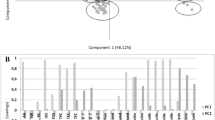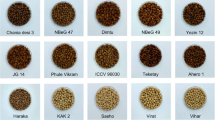Abstract
Chickpea is an important edible pulse able to be grown under rain-fed conditions. Chickpea kernels are quite rich in protein, carbohydrates, amino acids, vitamins and minerals, thus play a great role in daily diets. Present experiments were conducted for two years in 2018 and 2019 growing seasons with 27 kabuli chickpea genotypes registered between the years 1991–2013 under rain-fed and natural conditions. Chemical and organic fertilizers were not used in both years of the experiments. Experiments were conducted in randomized blocks design with 3 replications. For morphological traits, plant height, the first pod height, number of pods per plant, number of kernels per pod, number of kernels per plant, kernel yield and kernel protein contents were determined. For chemical composition of kernels, heavy metals (Cr, Ni), macro (Ca, K, Mg, Na, P, S) and micro elements (Cu, Zn, Mn, Fe) were determined. Significant increases and decreases were encountered in investigated traits based on registration years. Principal component analysis (PCA) for morphological traits and chemical composition of 27 different genotypes revealed that there were significant positive correlations between phosphorus and zinc contents and Akcin 91 cultivars was prominent for these two elements; there were positive correlations also between copper and iron and Cakır and Ilgaz cultivars were prominent for these elements. In terms of kernel yield, the cultivars (Aziziye 94 and Damla 89) registered in 1994 were found to be prominent. Kernel yields had positive correlations with Na content, but negative correlations with Ca, Fe, Cu and Mn contents.





Similar content being viewed by others
References
Alajaji SA, El-Adawy TA (2006) Nutritional composition of chickpea (Cicer arietinum L.) as affected by microwave cooking and other traditional cooking methods. J Food Compost Anal 19(8):806–812. https://doi.org/10.1016/j.jfca.2006.03.015
Babagil G (2011) Erzurum ekolojik koşulları da bazı nohut (Cicer arietinum L.) çeşitleri verim ve verim özelliklerinin incelenmesi. Anadolu Tarım Bilimleri Dergisi 26(2):122–127
Bicer BT, Albayrak Ö, Akıncı C (2017) Farklı ekim zamanlarının nohutta verim ve verim unsurlarına etkisi. J Adnan Menderes Univ Agric Fac. https://doi.org/10.25308/aduziraat.295351
Chen C, Chen S, Jha RK, Cotrozzi L, Nali C, Lorenzini G, Ma L (2020) Phenol metabolism of two cultivars of durum wheat (Triticum durum Desf.) as affected by ozone and flooding stress. J Agro Crop Sci 206(3):338–351. https://doi.org/10.1111/jac.12394
Ciftci CY, Önder M, Ceyhan E, Kaya M, Karaköy T, Akdoğan G, Benlioğlu B, Özaktan H (2020) Yemeklik baklagiller üretiminde mevcut durum ve gelecek. In: Türkiye Ziraat Mühendisleri IX. Teknik Kongresi, pp 395–418
Demirbas A, Karakoy T, Durukan H, Erdem H (2017) The impacts of the biochar addition in different doses on yield and nutrient uptake of the Chickpea plant (Cicer arietinum L.) under the conditions with and without incubation. Fresenius Environ Bull 26(12A):8328–8336
Erdemci İ (2012) Güneydoğu Anadolu bölgesi koşullarında farklı nohut (Cicer arietinum L.) genotiplerinin yazlık ve kışlık ekimlerinde bazı tarımsal ve teknolojik özelliklerinin belirlenmesi, p 45 (Fen Bilimleri Enstitüsü, Tarla Bitkileri ABD, Doktora Tezi)
Ereifej KI, Al-Karaki GN, Hammouri MK (2001) Seed chemical composition of improved chickpea cultivars grown under semiarid Mediterranean conditions. Int J Food Prop 4(2):239–246. https://doi.org/10.1081/JFP-100105190
FAO (2021). Food and Agriculture Organization of the United Nations. https://www.fao.org/faostat/en/#data/QV. Accessed: 15.12.2021
Gaur PM, Singh MK, Samineni S, Sajja SB, Jukanti AK, Kamatam S, Varshney RK (2016) Inheritance of protein content and its relationships with seed size, grain yield and other traits in chickpea. Euphytica 209(1):253–260. https://doi.org/10.1007/s10681-016-1678-2
Gozen V (2008). Morphologıc characterızatıon in hybrıd greenhouse cucumber (Cucumis sativus L.) breedıng and determınatıon of approprıate hybrıd combınatıons and hybrıd seed qualıty. Ankara University Graduate School of Natural and Applied Science Department of Horticulture, Ph.D. Thesis, 185s, Ankara
Gungor H, Dumlupınar Z (2018) Bazı nohut çeşit ve hatlarının verim ve verim unsurları bakımından değerlendirilmesi. Derim 35(2):194–200. https://doi.org/10.16882/derim.2018.444157
Gupta N, Shrivastava N, Bhagyawant SS (2017) Multivariate analysis based on nutritional value, antinutritional profile and antioxidant capacity of forty chickpea genotypes grown in India. J Nutr Food Sci 7(3):1000600. https://doi.org/10.4172/2155-9600.1000600
Kaur K, Grewal SK, Gill PS, Singh S (2019) Comparison of cultivated and wild chickpea genotypes for nutritional quality and antioxidant potential. J Food Sci Technol 56(4):1864–1876. https://doi.org/10.1007/s13197-019-03646-4
Kaur M, Singh N, Sodhi NS (2005) Physicochemical, cooking, textural and roasting characteristics of chickpea (Cicer arietinum L.) cultivars. J Food Eng 69(4):511–517. https://doi.org/10.1016/j.jfoodeng.2004.09.002
Kaya M, Kan A, Yilmaz A, Karaman R, Sener A (2018) The fatty acid and mineral compositions of different chickpea cultivars cultivated. Fresenius Environ Bull 27(2):1240–1247
Kose ÖDE, Mut Z (2020) Mineral contents of chickpea cultivars (Cicer arietinum L.) grown at different locations of Turkey. Sains Malays 49(2):293–303. https://doi.org/10.17576/jsm-2020-4902-07
Krouma A (2009) Physiological and nutritional responses of chickpea (Cicer arietinum L) to salinity. Turk J Agric For 33(5):503–512. https://doi.org/10.3906/tar-0902-12
Ma Z, Simpson Boye JI, Prasher BK, Monpetit SO, Malcolmson D (2011) Thermal processing effects on the functional properties and microstructure of lentil, chickpea, and pea flours. Food Res Int 44(8):2534–2544. https://doi.org/10.1016/j.foodres.2010.12.017
Mertens D (2005) AOAC official method 975.03. Metal in plants and pet foods. In: Horwitz W, Latimer GW (eds) Official methods of analysis, 18th edn., pp 3–4
Mohammadi SA, Prasanna BM (2003) Analysis of genetic diversity in crop plants salient statistical tools and considerations. Crop Sci 43:1235–1248. https://doi.org/10.2135/cropsci2003.1235
Olika E, Abera S, Fikre A (2019) Physicochemical properties and effect of processing methods on mineral composition and antinutritional factors of improved chickpea (Cicer arietinum L.) varieties grown in Ethiopia. Int J Food Sci. https://doi.org/10.1155/2019/9614570
Ozaktan H (2021) Technological characteristics of chickpea (Cicer arietinum L.) cultivars grown under natural conditions. Turk J Field Crops 26(2):235–243. https://doi.org/10.17557/tjfc.1018627
Ozaktan H, Doymaz A (2022) Mineral composition and technological and morphological performance of beans as influenced by organic seaweed-extracted fertilizers applied in different growth stages. J Food Compost Anal. https://doi.org/10.1016/j.jfca.2022.104741
Ozaktan H, Uzun S, Uzun O, Yasar Ciftci C (2022). Assessment of Agro-Morphological Traits of Common Bean Genotypes Grown Under Organic Farming Conditions with Multi-Variate Analyses and Applications. Gesunde Pflanzen 1–9
Ozer S, Karaköy T, Toklu F, Baloch FS, Kilian B, Ozkan H (2010) Nutritional and physicochemical variation in Turkish kabuli chickpea (Cicer arietinum L.) landraces. Euphytica 175(2):237–249. https://doi.org/10.1007/s10681-010-0174-3
Ramírez-Ojeda AM, Moreno-Rojas R, Cámara-Martos F (2018) Mineral and trace element content in legumes (lentils, chickpeas and beans): Bioaccesibility and probabilistic assessment of the dietary intake. J Food Compost Anal 73:17–28. https://doi.org/10.1016/j.jfca.2018.07.007
Sali A, Rusinovci İ, Shala-Mayrhofer V, Fetahu S, Dukagjin Z (2016) Genetic diversity for some nutritive traits of chickpea (Cicer arietinum L.) from different regions in Kosova. Turk J Field Crop 21(1):156–161. https://doi.org/10.17557/tjfc.57905
Sharma S, Lavale SA, Nimje C, Singh S (2021) Characterization and identification of annual wild Cicer species for seed protein and mineral concentrations for chickpea improvement. Crop Sci 61(1):305–319. https://doi.org/10.1002/csc2.20413
Thavarajah P (2012) Evaluation of chickpea (Cicer arietinum L.) micronutrient composition: Biofortification opportunities to combat global micronutrient malnutrition. Food Res Int 49(1):99–104. https://doi.org/10.1016/j.foodres.2012.08.007
Vandemark GJ, Grusak MA, McGee RJ (2018) Mineral concentrations of chickpea and lentil cultivars and breeding lines grown in the US Pacific Northwest. Crop J 6(3):253–262. https://doi.org/10.1016/j.cj.2017.12.003
Wang J, Qin L, Cheng J, Shang C, Li B, Dang Y, He H (2021) Suitable chemical fertilizer reduction mitigates the water footprint of maize production: evidence from Northeast China. Environ Sci Pollut Res. https://doi.org/10.1007/s11356-021-17336-2
Yalcın F, Mut Z, Erbaş Kose ÖD (2018) Afyonkarahisar ve Yozgat koşullarında yüksek verim sağlayacak uygun nohut (Cicer arietinum L.) çeşitlerinin belirlenmesi. Gaziosmanpaşa Üniversitesi Ziraat Fakültesi Dergisi 35(1):46–59. https://doi.org/10.13002/jafag4367
Funding
This study was supported by Turkish Scientific Research Council (TUBİTAK) with the project number of 119O226.
Author information
Authors and Affiliations
Corresponding author
Ethics declarations
Conflict of interest
H. Ozaktan, S. Uzun, O. Uzun and C. Yasar Ciftci declare that they have no competing interests.
Rights and permissions
Springer Nature or its licensor holds exclusive rights to this article under a publishing agreement with the author(s) or other rightsholder(s); author self-archiving of the accepted manuscript version of this article is solely governed by the terms of such publishing agreement and applicable law.
About this article
Cite this article
Ozaktan, H., Uzun, S., Uzun, O. et al. Change in Chemical Composition and Morphological Traits of Chickpea (Cicer arietinum L.) Genotypes Grown Under Natural Conditions. Gesunde Pflanzen 75, 1385–1400 (2023). https://doi.org/10.1007/s10343-022-00741-z
Received:
Accepted:
Published:
Issue Date:
DOI: https://doi.org/10.1007/s10343-022-00741-z




